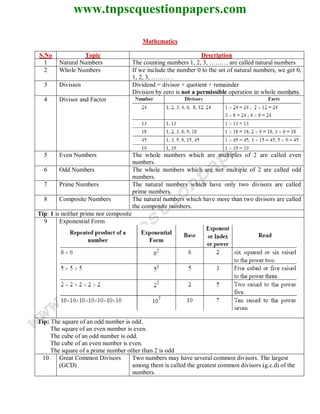The document discusses various topics in mathematics including natural numbers, whole numbers, division, prime numbers, fractions, ratios, proportions, percentages, profit and loss, simple interest, areas, volumes, algebraic expressions, and arithmetic and geometric progressions. It provides definitions, formulas, examples, and explanations for these essential mathematical concepts.














![68
a
www.tnpscquestionpapers.com
Binary Addition
com
69 Binary Subtraction
70 Compound tnpscquestionpapers.Interest: [ Compounded Anually ]
71 Volume of Right Circular Cylinder /
www.Volume of Right Circular Cone
,
72 Algebra Solve](https://image.slidesharecdn.com/tnpscmathematicssyllabusnotes-140903051756-phpapp01/85/Tnpsc-mathematics-syllabus_notes-15-320.jpg)












